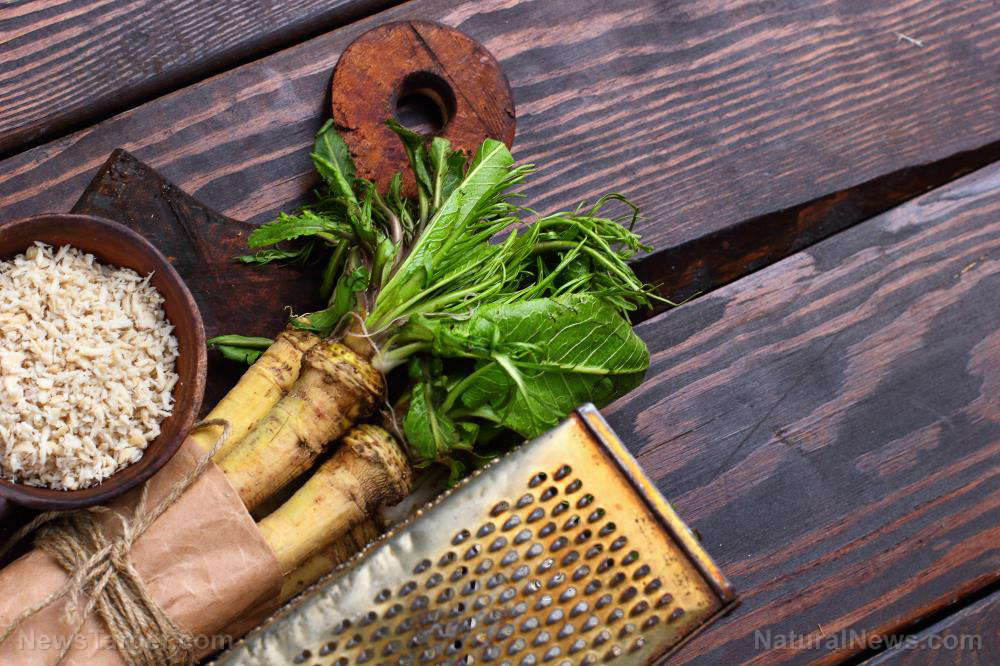The health benefits of horseradish include anti-cancer effects
12/01/2019 / By Melissa Smith

Horseradish might not be something you eat every day, but you may want to consider eating it more often. Researchers from the University of Illinois found that this root vegetable may protect against cancer.
In their study published in the Journal of Agricultural and Food Chemistry, researchers found that horseradish contains compounds that could help detoxify and remove cancer-causing free radicals in the body.
“We knew horseradish had health benefits, but in this study, we were able to link it to the activation of certain detoxifying enzymes for the first time,” said Mosbah Kushad, one of the authors of the study.
This study stemmed from their previous study in which they identified and quantified glucosinolates – the compounds in horseradish responsible for the cancer-fighting effect. They found that horseradish contains nearly 10 times more glucosinates than broccoli. Glucosinates increase the ability of the liver to detoxify cancer-causing chemicals and suppress the growth of existing cancerous tumors.
In the current study, the research team determined whether the USDA (U.S. Department of Agriculture) grades of horseradish roots vary in their phytochemical content or potential health-promoting properties. To do so, they looked for the products of glucosinolate hydrolysis, which stimulate enzymes involved in detoxifying cancer-causing substances. Then, they compared the quantity and activity of these products in 11 horseradish strains rated U.S. Fancy, U.S. No. 1, or U.S. No. 2.
The USDA puts horseradish roots in these categories based on their diameter and length. Horseradish roots sized 8 inches (in.) or longer with a 1.5 in. diameter are graded U.S. Fancy, while U.S. No. 1 is 6 in. and U.S. No. 2 is 4 in.

The research team discovered that the higher-grade U.S. Fancy horseradish roots had dramatically more glucosinolates than U.S. No. 1. They also found that concentrations of different glucosinolate hydrolysis products varied according to USDA grade. The U.S. Fancy had greater allyl isothiocyanate (AITC), while U.S. No. 1 had greater 1-cyano 2,3-epithiopropane (CETP).
These two compounds have different levels of cancer-fighting activity, with CETP being weaker than AITC. Still, the detection of CETP in horseradish is noteworthy because the team said that this is the first time that CETP from horseradish was detected and measured.
The researchers concluded that AITC is a good dietary cancer-fighting compound. It activates the enzyme responsible for detoxifying cancer-causing substances. In addition, it is greatly absorbed by the body – 90 percent of it is absorbed when ingested.
How to add horseradish to your diet
Horseradish has a pungent taste, but you would not guess it just by smelling it – an uncut or ungrated horseradish root is odorless. Its mustard-like oil can bring tears to your eyes and heat to your tongue. These are caused by its compound called isothiocyanate, which gives off heat when exposed by eating or crushing horseradish. The heat starts to go away once the horseradish is cut or grated and exposed to air. You can also neutralize the reaction and stabilize its flavor by immediately adding vinegar to freshly grated horseradish.
Horseradish tastes best and is most flavorful when freshly grated. While there are bottled varieties, it’s better to grate your own to make it more pleasing for your palate. You can grate horseradish by hand or by a food processor.
Horseradish is versatile and can be added to many dishes. You can use fresh horseradish or a creamy horseradish sauce as a condiment for steak or add grated horseradish to deviled eggs, potato salad, or homemade mayonnaise to give them a bit of a spicy kick. (Related: Horseradish treats a variety of health conditions, from asthma to toothache to gout pain.)
Did you know that the popular condiment wasabi is made from Japanese horseradish? Learn more about this anticancer superfood and more at Fresh.news.
Sources include:
Submit a correction >>
Tagged Under:
#nutrition, anticancer, food cures, food is medicine, Fresh, functional food, glucosinolates, grocery cures, Horseradish, natural cures, natural medicine, organics, prevention, remedies, vegetables, veggie
This article may contain statements that reflect the opinion of the author





















